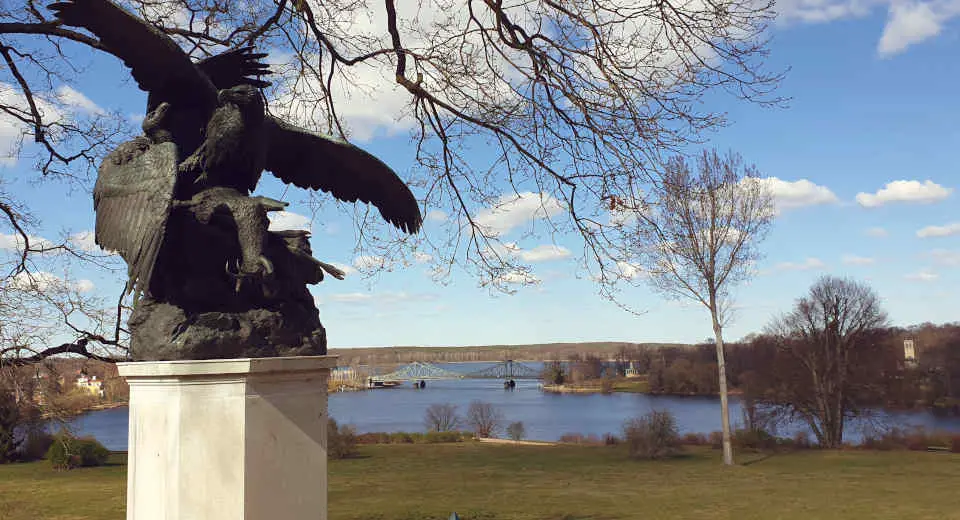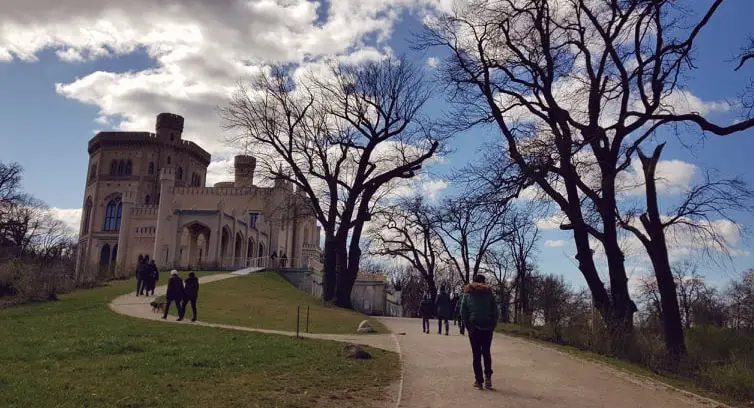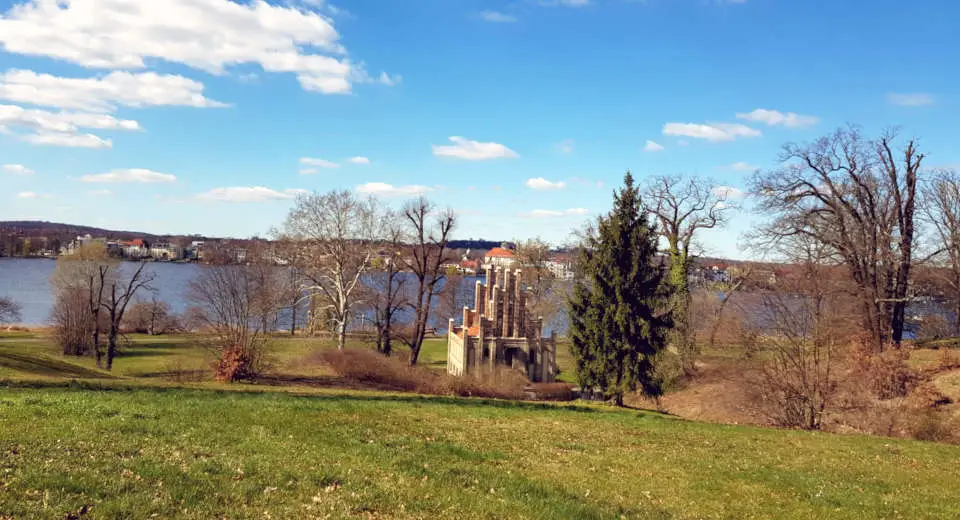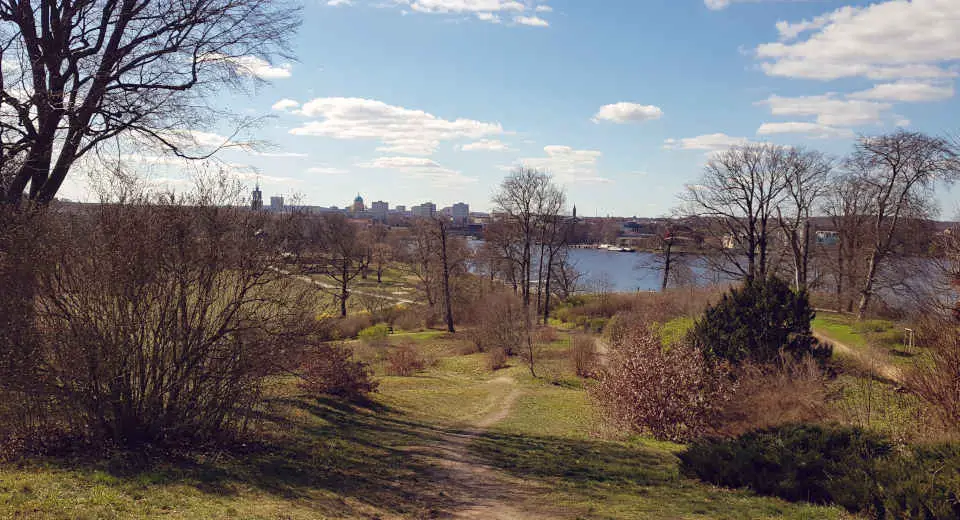In Babelsberg Park, history and beautiful nature await you. It is an ideal destination for couples and families. Strolling, taking pictures and going on a historical discovery tour – these are the ingredients for an unforgettable day.
Historical buildings are a yawn? No way! They were used for kissing, loving, scheming and, last but not least, for making politics. The historic buildings and monuments in Babelsberg Park are true witnesses of history – and also make great photo or drawing subjects! Whether it’s a castle, a steam engine house or the almost fairytale-like Flatow Tower. These buildings are history set in stone and contribute a great deal to the charm of Babelsberg Park.
After some 170 years, the trees are more beautiful than ever – as magnificent and venerable as those planned by the garden architects. Since 1833, Babelsberg Park was a palace park, only since 1927 it became a people’s park and thus open to the public. Some of the park’s meadows can be used for picnics and relaxation, and are marked with signs.

Surprising on the first visit is the size of the park: it covers 124 hectares! So there is no danger of getting fed up too quickly. Beautifully situated, the hilly park nestles on the banks of the Deep Lake of the Havel and Lake Glienicke, which merge into one another.
While walking, breathtaking views keep opening up to the visitor, for example of Potsdam with Sanssouci Palace, of the Glienicke Bridge and again and again: of wonderful garden architecture. You can spend hours here and explore a lot! Babelsberg Park is so varied that a long walk is worthwhile at any time of year – but nature is at its best in spring and summer.
Especially if you have children with you (or those uninterested in history), Babelsberg Park is particularly worthwhile. People spread out quickly in the spacious park and there is a lot to discover.
In the mood for more action? When the weather is nice, you can climb the treetops at Adventure Park Potsdam!
The Babelsberg Park – This Is What It Has to Offer!

Imperial residence, Berlin Wall, GDR, lido: Babelsberg Park is about 170 years old and marked by the eventful history of this time. A stroll through the park is a real foray into history. Today the park covers 172 hectares, and a network of well-maintained gravel paths runs through the large grounds.
This discovery tour is primarily concerned with Wilhelm I and the buildings he commissioned. There are several small architectural structures in Babelsberg Park, almost all of which relate theaetically to the military successes of the Prussian army in the time of Wilhelm I.
Highlights To Explore and Linger Over
- From the lookout platform on the Zehlendorf Böttcherberg in the park (66 m high) you have a great view!
- In the Small Palace there is a restaurant and café
- From April to October, the water games at Babelsberg Castle splash!
- From the top of the Flatow Tower you have a great all-round view over Potsdam (open May-October at weekends)
- The Steam Engine House, which looks like a medieval castle, but actually housed the pump for the water supply
- Exploring romantic terraces, oak bushes and arbours
- Garden architectural works of art to discover
- Stroll along the banks of the Havel and look for the most beautiful view of the Glienicke Bridge
My Discovery Tour in the Footsteps of Emperor Wilhelm I.

Start at the main entrance. From there you can take a round trip to the buildings commissioned by Emperor Wilhelm I. There are always several routes to choose from. There are always several routes to choose from. The beauty of the large buildings is that you can hardly miss them. 🙂
With a view of the Machine House, which looks like a medieval castle, the first architectural stop awaits us. This structure housed the steam-powered pump that supplied the park and castle with water.
Babelsberg Castle and Court Arbour
Now you can head straight for Schloss Babelsberg, situated on a hill, and stroll through the rose arbour and terraces. Alternatively, you can walk an arc along the banks of the Havel to Lenné Bay and head for the neo-Gothic Babelsberg Palace via the Rose Staircase. The architect K.F. Schinkel built Babelsberg Palace for Wilhelm I as a summer residence; it has a whole 99 rooms!
Next stop is a detour to the Judicial Arbour on the Lennéhöhe. It was truly brought here from the centre of Berlin and used to stand where the Red Town Hall is today. Here there was a tea room on the upper floor.
The Small Palace and the Marstall
Above the Small Palace now comes the simple Marstall, which housed horses and carriages as well as servants’ quarters.
In the restaurant and café in the Little Castle you can take a break with coffee and cake. The white Small Palace was built in the Tudor Gothic style for the Crown Prince and Crown Princess Friedrich Wilhelm and Victoria. It fell into oblivion after the death of Frederick William, later Emperor Frederick III.
Matrosenhaus and Bismarck Bridge
Along the shore of the Deep Lake you will reach the Matrosenhaus, where the sailors of the gondolas, imperial steamships and sailing ships of the emperor lived. This is where the imperial boats used to moor and set sail. Next stop is the Bismarck Bridge, where Wilhelm I is said to have persuaded Bismarck to become Realm Chancellor in 1862.
Flatow Tower, Victory Column and Magnificent Views
The circular route now takes us back, stopping at the beautiful Flatowturm, where fruit trees and forsythia blossom in spring. Once there was a drawbridge and a moat here! From there you have a great view over the Tiefen See to Potsdam. However, the view is even more magnificent from its top.
We keep to the right and enjoy some grandiose views, which are planned and designed as such: First the Augustablick, further to the Feldherrenbank and the Luisenhöhe up to the Siegessäule on the Victoriahöhe. The circular course ends at the eastern park entrance observatory.
Worth Knowing About Babelsberg Park

- Babelsberg Park has been a UNESCO World Heritage Site since 1990 and covers the Babelsberg district of Potsdam.
- Prince Wilhelm, later Emperor Wilhelm I, and his wife Augusta commissioned the park
- It was laid out in the mid-19th century by the garden architects Peter Joseph Lenné and Prince Hermann von Pückler-Muskau
- The famous architect Karl Friedrich Schinkel was commissioned to plan the palace at the heart of Babelsberg Park as the residence of Wilhelm I and Augusta
- The park area (since 1875) is 124 hectares
- There are artificial lakes in the park, the most resonant name being the “Black Sea”
- In the Babelsberg Palace Park, the neo-Gothic palace, the steam engine house, the small palace, the stables, the court arbour, the sailor’s house, the Flatow tower and several other buildings and garden architecture are spread over the extensive park
- In 1928, Babelsberg Palace and Park went to the Prussian Palace Department
- From 1945, large parts of the Havel riverbank in the park were a lido
- During the GDR era, some buildings were erected in the park
- The Berlin Wall was built in 1961 on the banks of Glienicker Lake / on the Teltow Canal and the beautiful riverside path could no longer be used by the public
- Currently, the Prussian Palaces and Gardens Foundation Berlin-Brandenburg is taking care of the palace and park administration and is gradually reconstructing Babelsberg Park according to the original plans of Lenné and Pückler.
Babelsberg Park – Facts
- Website: www.spsg.de
- Arrival: By train: The S-Bahn lines 7 and 5 go to Griebnitzsee. | By bus: At the eastern park entrance, bus 694 stops at the Sternwarte stop, it goes to Potsdam station. | By car: With your own car via the A115 or B1.
- Main entrance: At gatehouse I, Allee nach Glienicke 2 | Park entrance with gatehouse II, Grenzstraße / Alt Nowawes
- Second entrance: Eastern entrance, An der Sternwarte | entrance on Mühlenstraße / Jutestraße
- Opening hours: All year round from 8:00 a.m. until nightfall.
- Contact: Phone: 0331 – 9694222 // Email: [email protected]
- Age: For everyone
- Duration: approx. 2 hours
- Price: Free admission // € 2.00 voluntary contribution to the preservation and maintenance of Babelsberg Park
Looking for more tips for activities in Berlin and the surrounding area? Escape games, high ropes courses, nature tours or canoe trips, on Greatime you will find many ideas for activities with children, with friends or for couples.
Stay up to date and give us your Like on Facebook or follow Greatime on Instagram!

![Babelsberg Park Discovery Tour In The Footsteps Of Emperor Wilhelm I [Uber En="Flatow*tower*at*Park*Babelsberg" De="Flatowturm*im*Park*Babelsberg"]](https://greatime.de/wp-content/uploads/2021/03/park-babelsberg-flatowturm.jpg)
![Uber En Quot Bonfire Quot De Quot Osterfeuer Quot [Uber En="Bonfire*at*Easter*in*Brandenburg" De="Osterfeuer*an*Ostern*in*Brandenburg"]](https://greatime.de/wp-content/uploads/2024/03/ostern-in-brandenburg-osterfeuer.jpg)
![Uber En Quot Historic Clay Locomotive Quot De Quot Historische Tonlorenlok Quot [Uber En="Industrial*museum*and*nature*park*-*there*is*much*to*discover*in*the*Mildenberg*Zigeleipark" De="Industriemuseum*und*Naturpark*-*im*Ziegeleipark*Mildenberg*gibt*es*viel*zu*entdecken"]](https://greatime.de/wp-content/uploads/2020/07/ziegeleipark-mildenberg-lok.jpg)
![Uber En Quot Room Escape Games Quot De Quot Room Escape Games Quot [Uber En="This*is*what*Room*Escape*Games*are*-*they*are*available*in*many*cities" De="Room*Escape*Games*gibt*es*in*vielen*Städten*in*Deutschland"]](https://greatime.de/wp-content/uploads/2017/05/room-escape-games.jpg)